
The oscar is a species of fish from the cichlid family known under a variety of common names, including tiger oscar, velvet cichlid, and marble cichlid. In tropical South America, where the species naturally resides, A. ocellatus specimens are often found for sale as a food fish in the local markets. The fish has been introduced to other areas, including India, China, Australia, and the United States. It is considered a popular aquarium fish in Europe and the U.S.

Parachromis is a genus of cichlids native to Central America. Some species occur in Lake Nicaragua and Lake Managua. All species are predatory and relatively large for cichlids.
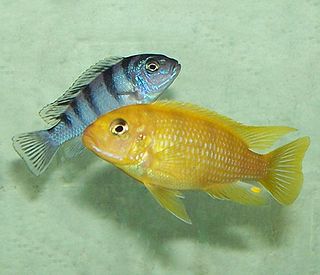
Maylandia lombardoi, is a 13 centimetres (5.1 in) long freshwater fish from the family Cichlidae. This species is popular in the aquarium hobby where it is sold under a variety of common names including: lombardoi mbuna, kenyi mbuna or kennyi mbuna or kenyi cichlid. This species is sometimes seen in the genus Metriaclima owing to a dispute in which a minority of cichlid researchers do not consider Maylandia valid (see Maylandia for discussion. The specific name honours the exotic fish dealer John Lombardo.

The Caesar grunt, also known as the black grunt, blacktail grunt, or redmouth grunt is a species of marine ray-finned fish, a grunt in the family Haemulidae. It is native to the western Atlantic Ocean

Nimbochromis livingstonii, Livingston's cichlid or (locally) kalingono, is a freshwater mouthbrooding cichlid native to Lake Malawi, an African Rift Lake. It is also found in the upper Shire River and Lake Malombe. They are found in inshore areas of the lake over sandy substrates.

Copadichromis borleyi is a species of haplochromine cichlid fish endemic to Lake Malawi in East Africa. The species is popular in the fishkeeping hobby where it is frequently kept in aquariums. The species has numerous common names, including redfin hap and goldfin hap.
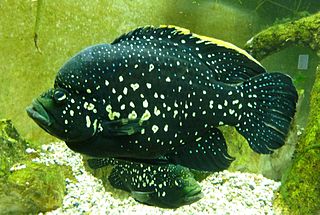
Paratilapia polleni is a medium-sized cichlid endemic to Madagascar. It is also a popular fish for display at public aquaria.
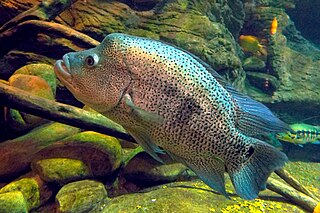
Parachromis dovii, the wolf cichlid, rainbow bass, or guapote, is a species of cichlid native to Central America, where it occurs in lakes, rivers and streams in Honduras, Nicaragua and Costa Rica. It is one of the largest cichlids, reaching up to 14 kg (31 lb) in weight and 80 cm (2.6 ft) long. A highly predatory species, it mostly feeds on other fish. P. dovii is important to local commercial fisheries, is sought after as a gamefish, and is sometimes kept in aquariums.

The sulfurhead aulonocara or sulfurhead peacock is a species of haplochromine cichlid which is endemic to Lake Malawi in the country of Malawi and has only been observed on West Reef and Eccles Reef. It is threatened by collection for the aquarium trade and this has caused a 70% reduction in numbers. In this mouthbrooding species, the eggs are cared for by the females only, and it is found over mixed sand and rocky areas where they hunt small invertebrates in the sand. It closely resembles the blue orchid aulonocara though it develops a yellow blaze across its dorsal In the past these two taxa have been considered to be subspecies. The specific name honours Hans-Joachim Mayland, an author on cichlids and a fishkeeper, brought the species to the attention of Ethelwynn Trewavas.
Copadichromis geertsi is a species of haplochromine cichlid which is endemic to Lake Malawi.
Astatotilapia flaviijosephi, the Jordan mouthbrooder, is a vulnerable species of freshwater fish in the family Cichlidae (cichlids). It is found in the central Jordan River system, including Lake Tiberias (Kinneret), in Israel, Jordan and Syria, making it the only haplochromine cichlid to naturally range outside of Africa. This species is too small to be of significant importance to fisheries, unlike the only other cichlids native to the Levant, the economically important tilapias.
Oxylapia is a genus of freshwater fish in the family Cichlidae. It contains the single species Oxylapia polli, known locally as the songatana. It is an endangered species, endemic to the Marolambo Rapids in the Nosivolo River in east-central Madagascar. It is threatened by habitat loss and sedimentation caused by deforestation. The only other monotypic cichlid genus in Madagascar is Katria, and it is restricted to the same region as Oxylapia. In 2010, the Nosivolo River was designated as a Ramsar Site. The Oxylapia is the conservation flagship species for the district capital Marolambo.

The damba is a species of cichlid.
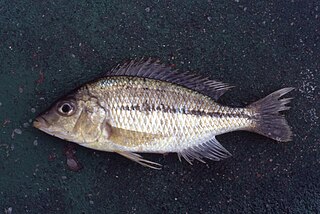
Protomelas kirkii is a species of cichlid endemic to Lake Malawi where it is most commonly found in areas vegetated with Vallisneria. This species can reach a length of 18 centimetres (7.1 in) TL. This species can also be found in the aquarium trade.

Plectorhinchus polytaenia, the ribboned sweetlips, also known as Tesone di mare or yellow-ribbon sweetlips, is a species of marine ray-finned fish, a sweetlips belonging to the subfamily Plectorhinchinae, one of two subfamilies in the family Haemulidae, the grunts. It is native to the Indian Ocean and the western Pacific Ocean.

Apolemichthys xanthurus, the Indian yellowtail angelfish, is a species of marine angelfish belonging to the family Pomacanthidae. Other common names include cream angelfish, smoke angelfish, and yellowtail black angelfish. It is found in the Indian Ocean.
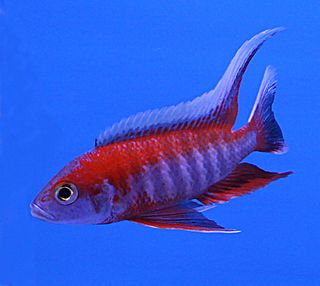
Aulonocara jacobfreibergi, the eureka red peacock, is a species of fish in the family Cichlidae. It is also known as Freiberg's peacock or fairy cichlid. There are several colour morphs including red or yellow. They generally can grow to around 15 cm in length.
The dara is a species of marine ray-finned fish, a grunt belonging to the family Haemulidae. It is native to the Atlantic coast of Africa. It is the only species in the monospecific genus Parakuhlia.

Hemichromis letourneuxi is a species of cichlid which is native to West Africa and is popular in the aquarium hobby and it has been introduced to the Caribbean and the south-east United States where it is invasive.
Chaetodontoplus ballinae, the Ballina angelfish, is a species of marine ray-finned fish, a marine angelfish, belonging to the family Pomacanthidae. It is endemic to eastern Australia.
















